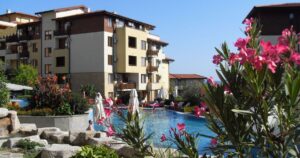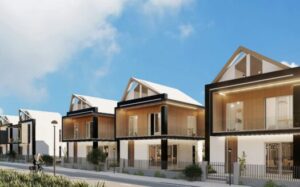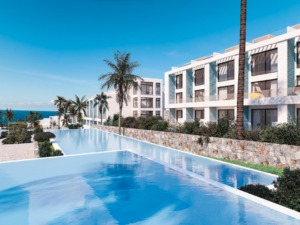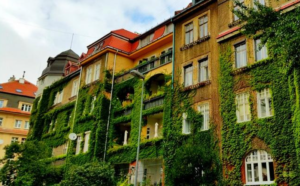
Foreigners are actively buying housing in Bulgaria, forming a significant share of transactions in the real estate market, according to local specialized associations and agencies.
According to the Bulgarian Real Estate Association, in 2024-2025 the greatest interest is shown by citizens of the UK, Germany, Greece, Israel, Romania and Ukraine. The most demanded objects on the Black Sea coast (Varna, Burgas, Nessebar) and in mountain regions popular for winter tourism (Bansko, Pamporovo).
Top 10 countries of real estate buyers in Bulgaria (2024-2025):
UK
Germany
Greece
Israel
Romania
Turkey
Italy
Russia
Ukraine
Poland
Experts note that the demand of foreigners stimulates the growth of prices: over the year the cost of housing in seaside resorts increased by 8-10% on average, in Sofia – by 6-7%. Apartments in new buildings in the middle segment (from €60 thousand), as well as apartments for rent to tourists remain popular.
Ukrainians are firmly entrenched in the top ten foreign buyers: their interest is due to both temporary relocation because of the war, and investment motives – the possibility of renting out housing in resort cities.
At the same time analysts predict further growth of demand from citizens of Ukraine and Israel, as well as revival of interest from EU countries, where housing prices are much higher than in Bulgaria.

According to the Bank of Greece (BoG), foreign investment in Greek real estate rose to €2.75 billion in 2024, coming mainly from EU countries, while maintaining high growth rates.
Quarterly data also confirms high interest, especially in tourist regions and large cities. In the first six months of 2024, real estate purchases accounted for 54.2% of all foreign direct investment (FDI) in the Greek economy — an absolute record.
Top 10 countries investing in Greek real estate (approximate data)
Unfortunately, BoG’s public data does not yet reveal the exact figures for each country, but some trends are clearly visible:
Ukrainians and Russians are represented, but their share is not among the top three countries investing in real estate. Their contribution is comparable to other investments from Eastern Europe — most likely within the 3-5th echelon, depending on regional preferences.
The main buyers are concentrated in Athens, Attica, Thessaloniki, Chalkidiki, as well as on popular islands such as the Cyclades and Ionian Islands. The apartment segment remains the leader — about 64% of investments, followed by villas and townhouses (~19%).

According to data from the Cypriot Ministry of Internal Affairs presented to parliament, as well as reports from Cypriot media, foreign buyers purchased more than 37,000 properties on the island between 2021 and 2024.
Top 10 buyer countries (2021–2024)
The statistics show some regional characteristics, for example, in Paphos, the British traditionally lead (~4,500 properties), in Limassol, the Russians lead (~2,500), followed by the British and Israelis. In Larnaca, the British, Lebanese, and Israelis are active, while in Nicosia, a significant portion of transactions are carried out by Greeks and British.
Since 2021, foreigners have purchased more than 37,000 properties, while Cypriot citizens have purchased more than 200,000. Transactions involving foreigners are concentrated in Limassol and Paphos (about 60% of all transactions).
The main trends in the Cyprus residential real estate market are:
Experts predict further growth in interest from citizens of Israel, Lebanon, and Ukraine, as well as a possible revival of Chinese investors as currency restrictions ease.

Vietnam has significantly expanded its visa-free regime, adding 12 European countries to the list of countries whose citizens can stay in the country for up to 45 days without a visa. This is valid from August 15, 2025, to August 14, 2028, and covers EU countries such as Belgium, Poland, the Czech Republic, and others that have joined the existing list, which includes France, Japan, the UK, and others.
This has signaled a revival in the resort real estate market: tourists with long visa-free periods and high incomes have become actively interested in buying villas, apartments, and condo hotels, especially in tourist areas. The Vietnam Association of Real Estate Agents (VARS) notes an increase in demand and a steady recovery in the sector.
The foreign population in the country is small but diverse:
Real estate purchase prices (per square meter):
Rental prices (per month):

The Relocation.com.ua project has prepared a fresh overview of the Slovak housing market (in the first half of 2025) in three sections — prices/sales, rentals, and construction:
Prices and sales continued to grow. In Q2 2025, the average price of residential real estate in Slovakia rose to €2,777/m², which is +12.8% y/y (and +2.9% compared to Q1). This is a new historical maximum according to NBS data. In Q1, the figure was €2,700/m² (+11.4% y/y). Growth is synchronous for apartments and houses, faster in large cities and regional centers.
The capital has seen a sustained upturn: according to media market data, in Q2, the average price of apartments approached €3,100/m², exceeding the peak of 2022 (the old housing stock is growing faster than new construction).
After a weak Q1 (due to the effect of the VAT increase from 20% to 23% from 2025), Q2’25 in Bratislava showed a sharp rebound — ~797 new buildings sold, which is +60% q/q and the second-best result in four years. For the whole of 2024, sales of new buildings in the capital doubled (1,664 vs. 773 in 2023) — part of the demand was “carried over” due to VAT.
The cost of local mortgages continues to normalize: the average rate for residential loans with a 5–10-year fixed term in June was ~3.0%, which supports solvent demand.
The rental market in 2025 is “cooler” than the price market. The supply of apartments for rent has increased, and average rates in a number of regions have been adjusted downward. At the same time, Bratislava remains the most expensive: the average rent is ~€890/month; the most affordable region among the large ones is Trenčín (~€544/month). There is a significant spread across the capital’s districts.
The gross rental yield in the country is about 4.9% (Q2’25); a year ago it was ~5.3%: profitability is slightly “eaten away” by the outpacing growth in purchase prices.
Housing construction is slowing down: in Q1 2025, 3,119 apartments/houses were completed — the lowest number in 9 years, −24% y/y (data from the State Statistics Office). This is the result of a weak flow of starts in 2023–2024 against the backdrop of expensive money and regulatory uncertainty.
It should also be noted that on April 1, 2025, a new Construction Law came into force, combining zoning and permitting into a single procedure designed to speed up the issuance of permits and reduce bureaucracy. The effect on the statistics of permits and completions will gradually become apparent in the second half of 2025–2026.
By mid-2025, Slovakia will be a “seller’s market” in terms of prices and a “tenant’s market” in terms of rents: prices will reach new highs amid cheaper mortgages and limited completions, while rents will stabilize due to increased supply.
If current trends continue, annual price growth is likely to slow down by the end of the year, but levels will remain high and housing supply will remain below pre-crisis levels.

In the first quarter of 2025, foreigners purchased €113.5 million worth of real estate in Montenegro (-21% year-on-year), with citizens and companies from Serbia, Turkey, and the US being the largest buyers, according to data from the Central Bank of Montenegro (CBCG) published by Vijesti.
Ukrainian citizens ranked 11th, along with buyers from Poland and the Czech Republic.
Ranking of countries by purchase volume, Q1’2025
Outside the top ten, Ukraine, Poland, and the Czech Republic are in 11th place (€2.3 million each), followed by Bosnia and Herzegovina (€1.9 million), Canada, and France (€1.4 million each). The geography of the deals covers buyers “from five continents,” the source notes.
According to CBCG, in January-March 2025, the total inflow of FDI into Montenegro amounted to €211 million, of which 54% was accounted for by real estate purchases. Other forms of FDI (investments in companies/banks, intra-group loans) declined. Monstat records a steady increase in prices for new buildings: the average price exceeded €2,000/m²; the coastal region remains the most expensive.
The rating is based on the value of transactions concluded in Q1’2025 according to official statistics from the Central Bank of Montenegro (CBCG) published in Vijesti; the countries and amounts are given in euros. The final annual results are usually published by the CBCG in consolidated reports.
Source: https://t.me/relocationrs/1340